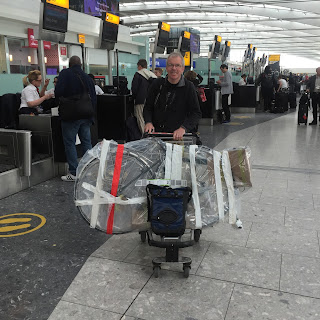Midsummer winter - 18th-20th June
For the next two days I travelled through a landscape of
sand dunes and pine forest. The forest
was planted over a hundred years ago to stabilise the dunes, which have a habit
of moving around if left to their own devices. The weather remained
unseasonably cold, but at least it didn’t rain.
 |
| Bunkers overlooking the road |
 |
| Suspected WW2 concrete |
 |
| Holiday village |
On this part of the coast the remains of the Second World
War are everywhere. Bunkers nestle in
the dunes, overlooking the road and the sea.
Where there aren’t bunkers there are vast holiday villages, often linked
by stretches of concrete track that must also be remnants of the war. At Lokken the NSCR takes to the beach for
14km, but I’d had more than enough sand coating my bike in the last few days,
so I kept to the road past a famous sand-engulfed lighthouse, through farmland
and forest and eventually into the teeth of a bitter NW wind as I headed back
to the coast and campsite at Svinkløv where I stood shivering in reception
while the owner made me a cup of coffee.
I went down on the beach and it was winter cold.
 |
| The lighthouse in the sand |
 |
| Just like winter |
Next day was sunnier and at times almost felt warm. I cycled
up to a headland at Bulbjerg topped with a massive bunker, then through more
dunes and forest and holiday villages to the small fishing port of Hantsholm,
which has a big fishing harbour and plentiful WW2 relics and all its shops in
one small shopping mall. At Hantsholm
the coast of Jutland turns south. I kept
to the road, which was smooth and empty apart from a couple of peletons of
cyclists in training. I never did find
out what they were training for. There were curlews and cuckoos and masses of
purple orchids in the verges. I camped
that night at Stenbjerg but I can’t remember a thing about it! What with the dunes and the forests and the
holiday villages everything had started to blur, but in the morning most things
changed.
 |
| The road behind the dunes |
Not the weather though. It continued cold, with the wind in
the north-east, and the small seaside village of Agger was waiting for the
season to begin. The burger bar was open
but the café only opened on Saturdays and Sundays. For a moment I was optimistic, but then I
realised it didn’t open until 12.00.
There was a tourist information booth which was open, but short on
information. At the roadsides, stalls had sprung up selling new potatoes to
celebrate midsummer. It was bleak and chilly.
 |
| Agger |
 |
| Midsummer potato stall |
South of Agger the road and path effectively cross the North
Sea, as a tidal surge in 1862 separated the northern part of Jutland from the
rest of Denmark, turning it into an island.
With sea and salt-marsh on both sides there are incredible numbers of birds.
As I cycled along the path, flocks of starlings were constantly rising into the
air around me. There were dozens of
swans on the water, kestrels, skuas, and all kinds of small birds.
In the distance, a factory chimney spewed out
dark smoke that was flattened by the wind and drifted eastwards. The path ended at a ferry, which took me across
the canal to Thyborøn. It was not the
longest ferry crossing of my trip, but it was certainly the smelliest. The smoke came from a gigantic
fish-processing plant and the stink was indescribable. Huge ships in various
states of decay and repair floated in the docks. Ropes and nets were piled high on the
quays. South of the town the
arrow-straight path across the marshes resumed, and when it ended I was in
another new landscape of gently undulating farmland with small white churches
glinting in the distance on the hilltops.
There were wheatfields now, and fields of oilseed rape, and wild pink
roses by the roadside along with the orchids.
I paused at a small shop where they had a grinder you could
use to grind your own organic flour. The
shop was full of organic food, and the shopkeeper told me it was because loads
of people moved there from Copenhagen in the nineteen-seventies. That must also have been the reason for the
sudden proliferation of Galleris and Kerimiks. I bought some very nice cheese!
There followed another causeway across the mouth of a fjord, with a sluice halfway along at Torsminde where there was a museum entirely devoted to the items salvaged from the wreck of an British warship, the St George, which sank in 1811, together with another British ship, with the loss of 1,391 lives. Unfortunately it was just closing when I arrived, but I did have time to buy some postcards. Eventually, after a diversion through countryside which felt just like being in Norfolk, I reached a campsite at Vedersø Klit where I passed an eventful night which I will describe next time.
Maps are here: To Svinkløv; To Stenbjerg; To Vedersø Klit









Comments
Post a Comment